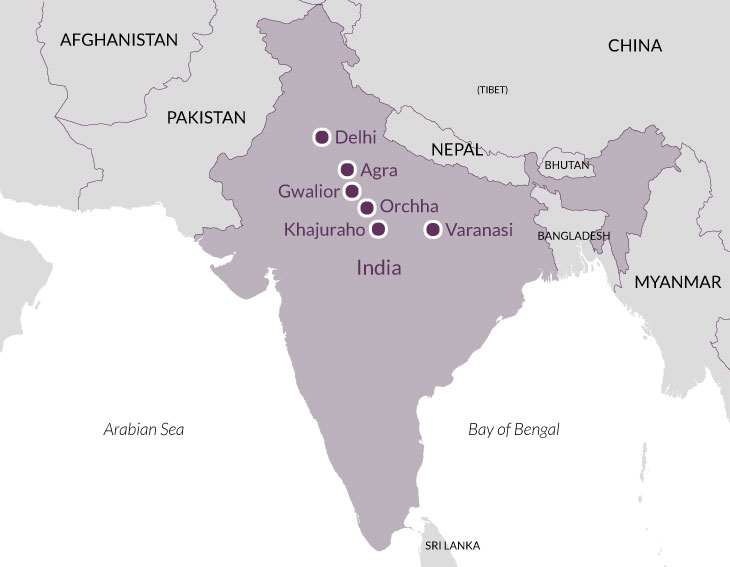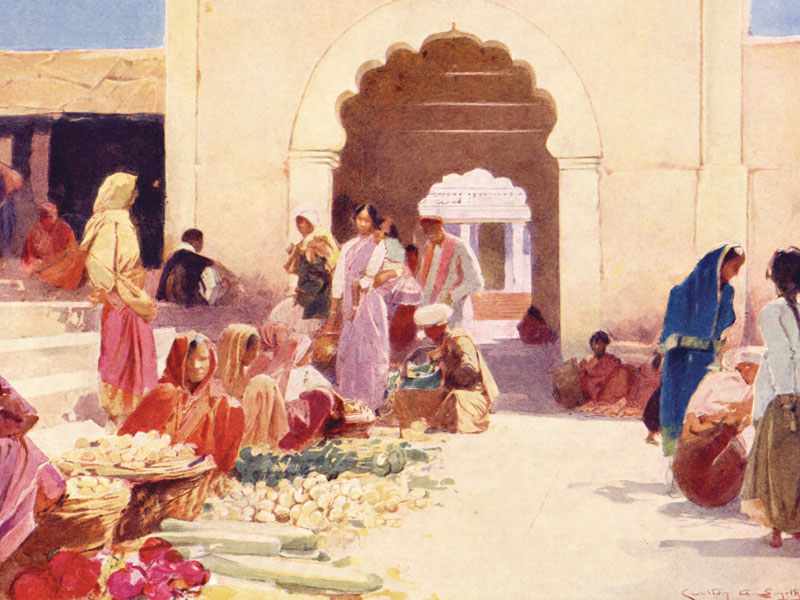Overview
The rich and fertile riverine plains of northern India have long formed a corridor allowing migrations and invasions to spread across the Subcontinent. The result is an area of fascinating cultural diversity.
Like the Ganges and the Yamuna, the sacred rivers of Hindu lore, this tour runs through the modern state of Uttar Pradesh and neighbouring Madhya Pradesh. But these geo-political boundaries do not restrict it thematically. Participants are treated to a comprehensive overview of the history of the Subcontinent, from the emergence of Hinduism and Buddhism to the decline of the Mughal Empire, the last Islamic power before the British Raj of the nineteenth century.
Located on the banks of the Ganges, Varanasi is India’s most sacred place and claims to be the oldest continuously inhabited city in the world. Founded by Lord Shiva, the city is mentioned in scriptures dating from the early Vedic period, in the second millennium BC. It was known as Kashi, the Luminous, during the life of the Buddha who visited on several occasions on his way to Sarnath nearby where he preached his first sermon. Pilgrims still flock here to wash away their sins in the holy Ganges. The modern Varanasi is also a place of learning and culture, with the first Hindu university in India.
The Chandelas of Khajuraho and the Bundelas of Orchha are two Rajput clans tracing lineage to the Lunar Dynasty from Varanasi, a commonly used device to claim political authority. The 11th-century Chandelas built intricately carved temples in Khajuraho, today celebrated (and often misunderstood) for their sensual carvings. They are superb examples of the Nagara or northern style of sacred architecture, with its linear succession of halls leading to the sanctum, topped by a Sikhara, or mountain-peak tower.
Later Bundela Rajputs built impressive palaces and temple-like cenotaphs in the lush landscape of northern Madhya Pradesh. Their palaces bring together elements borrowed from both the Rajput and Mughal traditions, while their funerary architecture asserts their dynastic authority.
The buildings and arts of the Mughals in the 16th and 17th centuries are often regarded as the apex of India’s artistic achievements, a prestige due no doubt in no small part to its best-known representative, the Taj Mahal, a creation which hovers somewhere between architecture, jewellery and myth. White marble is typical of the late period, while earlier buildings are of red sandstone – the deserted capital of Akbar at Fatehpur Sikri, and the Red Fort of Agra.
Delhi is among a rare elite of the world’s cities which have been capital of several successive regimes. With most new ruling powers establishing their headquarters on a site adjacent to its predecessors, the architectural legacy ranges from a monumental 13th-century minaret to the majestic expansiveness of Lutyens’ New Delhi. Empire succeeds empire; eighteen years after the Viceroy took up residence in Government House it was handed over to an independent India.
Day 1
Delhi. Rooms are available from 2.00pm on 8th November, allowing for early check-in today. Nothing is planned before a pre-lunch talk. Humayun’s striking tomb, with its high-arched façades set in a walled garden, is an important example of early Mughal architecture. First of two nights in Delhi.
Day 2
Delhi. The Jama Masjid, India’s largest mosque, dominates Old Delhi with its minarets and domes. Rickshaw through the labyrinthine streets near Chandni Chowk. After lunch, visit the severely beautiful 15th-century tombs of the Sayyid and Lodi dynasties are located in the serene Lodi Gardens, close to the hotel.
Day 3
Delhi to Varanasi. Fly mid-morning from Delhi to Varanasi (IndiGo). After lunch in the hotel, walk in the old town, visiting hidden shrines and experiencing the busy life along the river. The Dasaswamedha Ghat is named after the ancient ten horse sacrifice which took place here in mythical time; a boat ride along the Ganges ends here with the evening river blessing ceremony (Aarti), a ritual going back to the Vedic Age. First of two nights in Varanasi.
Day 4
Sarnath, Varanasi. Begin the day with a boat ride at sunrise, followed by breakfast and a morning walk through the alleys of the old city. Buddha preached his first sermon at Sarnath and the site remains an active Buddhist centre. The Dhamek stupa in the Deer Park marks the spot where the Buddha sat to preach. The museum houses the 3rd-century BC lion capital which has become the symbol of modern India since independence.
Day 5
Varanasi to Delhi. Located on the eastern bank of the Ganges, visit Ramnagar Fort, an 18th-century fort built by Kashi Naresh Raja Balwant Singh in typical Mughal style. After lunch, fly to Delhi (IndiGo). Overnight in Delhi.
Day 6
Delhi to Khajuraho. In the morning, visit the Qutb Minar, site of the first Islamic city of Delhi, established in 1193 on the grounds of a defeated Rajput fort. The towering minaret and its mosque survive as testament to the might of the invaders. Fly to Khajuraho (SpiceJet) in the afternoon. First of two nights in Khajuraho.
Day 7
Khajuraho. The spectacular western group of temples built during the Chandela Rajput dynasty, famous for the beautifully carved erotic scenes. The awe-inspiring 11th-cent. Kandariya Mahadev Temple is one of the finest examples of North Indian temple architecture, richly embellished with sensuous sculptures depicting the god’s heavenly abodes. Nearby, the Jagadambi Temple contains excellent carvings of Vishnu. In the afternoon, visit the southern groups of temples.
Day 8
Khajuraho to Orchha. Drive to Orchha. Located close to the Betwa River on dramatic rocky terrain, Orchha’s former glory as capital of the Bundela kings is evident in the multi-chambered Jehangir Mahal with lapis lazuli tiles and ornate gateways. The Raj Mahal palace contains some beautiful murals with religious and secular themes. Elegant Royal Chhatris (cenotaphs) line the ghats of the Betwa. Overnight in Orchha.
Day 9
Orchha. A walk in the old town includes a visit to the high-ceilinged Chaturbhuj Temple; the cross plan represents the four-armed Vishnu. The Lakshmi Temple incorporates fortress elements and its 19th-century frescoes depict scenes of the 1857 Indian Rebellion. Afternoon journey from Jhansi to Gwalior by train. First of two nights in Gwalior.
Day 10
Gwalior. Athwart a steep-sided hill, the formidable Gwalior Fort is lavishly embellished with cupolas and blue tiles; inside are superb 9th- and 11th-century temples. The afternoon is at leisure with the option of a visit to a nearby palace.
Day 11
Gwalior, Agra. Drive to Agra and in the afternoon visit both the magnificent Red Fort, built by Akbar and the best preserved of the palaces built during his reign, and the I’timād-ud-Daulah (c. 1628), an exquisite garden tomb and the first Mughal building clad in white marble inlaid with pietra dura. First of two nights in Agra.
Day 12
Agra, Fatehpur Sikri. Rise early to visit the Taj Mahal in the first light of day. It was commissioned by Shah Jahan in memory of his third wife, Mumtaz Mahal, and completed in 1648. Breakfast at the hotel. Drive out to Fatehpur Sikri, a new capital built by Akbar (1570) but abandoned after a mere 15 years. The palace complex consists of a series of courtyards and beautifully wrought red sandstone pavilions.
Day 13
Sikandra, Delhi. Drive to Delhi via Akbar’s mausoleum at Sikandra, built on his death in 1605. Set in a traditional char-bagh, it has no central dome unlike other Mughal mausolea. In New Delhi, where Lutyens, Baker and other British architects created a grand city with unique designs, visit the National Museum which houses a collection of art covering 5,000 years of Indian history. Overnight Delhi.
Day 14
Delhi. Car transfers to Delhi airport can be arranged for your onward journey.

Dr Giles Tillotson
Fellow (and former Director) of the Royal Asiatic Society, Giles is currently Senior Vice President at DAG (a Delhi-based art gallery). He was earlier Consultant Director at the City Palace in Jaipur, and before that Reader in History of Art and Chair of Art & Archaeology at SOAS. His specialisms include the history and architecture of the Rajput courts of Rajasthan and of the Mughal cities of Delhi and Agra; Indian architecture in the period of British rule and after Independence and landscape painting in India. Books include Taj Mahal, Jaipur Nama: Tales from the Pink City, Mughal India, The Tradition of Indian Architecture, and the novel, Return to Bhanupur.
Price, per person
Two sharing: £7,150. Single occupancy: £8,650.
Included
Flights with IndiGo: Delhi to Varanasi and Varanasi to Delhi, and with SpiceJet: Delhi–Khajuraho; travel by private air-conditioned coach, people carriers and one journey by train from Jhansi to Gwalior; accommodation as described below; breakfasts, 12 lunches and 10 dinners with wine or beer, water and coffee; all admissions; all tips; the services of the lecturer, tour manager and local guides.
Flights
Flights from London to Delhi are not included in the price of the tour. We will send the recommended flight options when they come into range (by January 2024) and ask that you make your own flight reservation.
Visas
Required for most foreign nationals, and not included in the tour price. We will advise all participants of the process.
Accommodation
Taj Mahal Hotel, New Delhi: a modern and comfortable hotel with an attractive garden and swimming pool. The hotel is well-situated in the heart of Lutyens’s Delhi and caters for both the business and leisure traveller. Taj Ganges Hotel, Varanasi: a comfortable 4-star hotel outside city centre. Lalit Temple View Hotel, Khajuraho: a modern hotel located within walking distance of the main sites. Hotel Amar Mahal, Orchha: the most basic of the hotels on the tour, this 3-star equivalent is conveniently located and adequately equipped. Taj Usha Kiran Palace Hotel, Gwalior: a former palace converted into a charming hotel. Trident Hotel, Agra: comfortable, well-run, modern 4-star close to the main sites with a spacious garden. Roseate House Hotel, New Delhi: a 5-star hotel conveniently close to the airport.
How strenuous?
A good level of fitness is essential. Unless you enjoy entirely unimpaired mobility, cope with everyday walking and stair-climbing without difficulty and are reliably sure-footed, this tour is not for you.
A rough indication of the minimum level of fitness required is that you ought to be able to walk briskly at about three miles per hour for at least half an hour, and undertake a walk at a more leisurely pace for an hour or two unaided. You may be on your feet for lengthy stretches of time. Uneven ground and irregular paving are standard.
There are three 3-hour long coach journeys where facilities are limited. There are some fairly steep ascents to forts and palaces. Steps to temples and palaces can be steep and slippery. Unruly traffic and the busy streets of Delhi also require vigilance. Average distance by coach per day: 45 miles.
Are you fit enough to join the tour?
Group size
Between 10 and 22 participants.
Travel advice
Before booking, please refer to the FCDO website to ensure you are happy with the travel advice for the destination(s) you are visiting.
Combine with
2024:
Gastronomic Catalonia, 28 October–4 November
Florentine Palaces, 30 October–3 November
Art in Madrid, 30 October–3 November
Opera at Wexford, 30 October–3 November
Music of the Czech Lands, 31 October–5 November
The Romans in Britain, 6–8 November

'Excellent. A wonderful introduction to the charms of Northern India.'
'The mix of famous sites and less familiar ones was wonderful - this tour is superbly organised and I am astonished at how much you managed to include in the two weeks.'
'I saw things I would never be able to see on my own.'
'A splendid assortment of places, experiences, people, flavours of India. A fine overview on my first trip.'
'We enjoyed every minute and we're sorry that we had to come home.'
'Whetted our appetite for more.'
'Everything was thought out with consideration for nervous western people not familiar with this huge Sub Continent and its complexities.'
